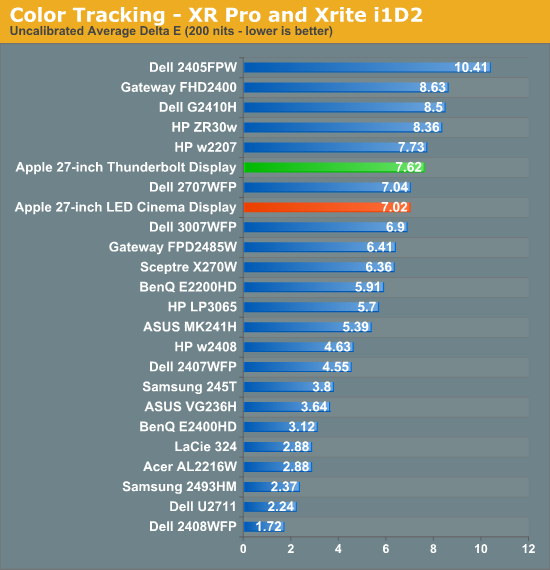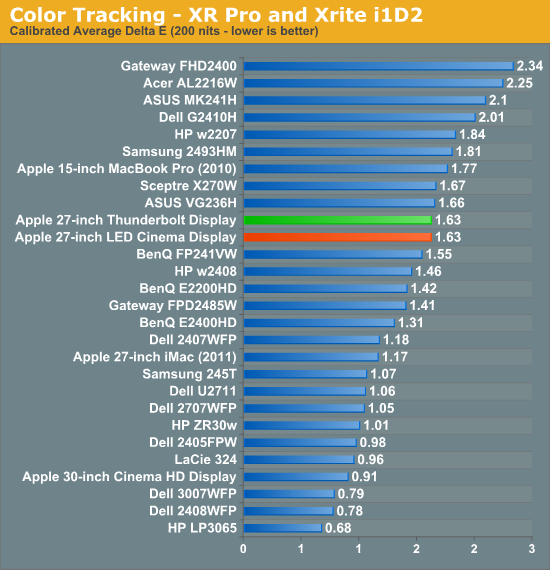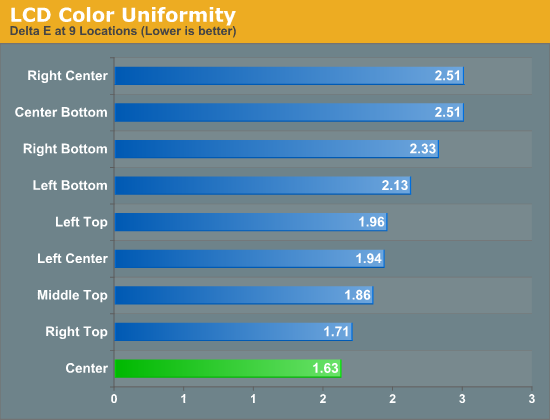The Apple Thunderbolt Display Review
by Anand Lal Shimpi on September 23, 2011 2:56 AM EST- Posted in
- Displays
- Mac
- Apple
- Thunderbolt
- Thunderbolt Display
Display Testing
With all of the extra connectivity there is to test with the Thunderbolt Display we can't forget the actual panel testing. Thankfully this part is pretty simple, the display characteristics are near identical to the 27-inch LED Cinema Display we reviewed last year.
Color Quality
We report two main quality metrics in our display reviews: color accuracy (Delta-E) and color gamut. Color gamut refers to the range of colors the display is able to represent with respect to some color space. In this case, our reference is the AdobeRGB 1998 color space, which is larger than the sRGB color space. So our percentages are reported with respect to this number, and larger is generally better.
Color accuracy (Delta E) refers to the display’s ability to display the correct color requested by the GPU and OS. The difference between the color represented by the display, and the color requested by the GPU is our Delta-E, and lower is better here. In practice, a Delta E under 1.0 is perfect - the chromatic sensitivity of the human eye is not great enough to distinguish a difference. Moving up, a Delta E of 2.0 or less is generally considered fit for use in a professional imaging environment - it isn’t perfect, but it’s hard to gauge the difference. Finally, Delta E of 4.0 and above is considered visible with the human eye. Of course, the big consideration here is frame of reference; unless you have another monitor or some print samples (color checker card) to compare your display with, you probably won’t notice. That is, until you print or view media on another monitor. Then the difference will no doubt be apparent.
As I mentioned in our earlier reviews, we’ve updated our display test bench. We’ve deprecated the Monaco Optix XR Pro colorimeter in favor of an Xrite i1D2 since there are no longer up-to-date drivers for modern platforms.
For these tests, we calibrate the display and try to obtain the best Delta-E we can get at 200 nits of brightness for normal use. We target 6500K and a gamma of 2.2, but sometimes the best performance lies at native temperature and another gamma, so we try to find what the absolute best performance could be. We also take an uncalibrated measurement to show performance out of the box using either the manufacturer supplied color profile, or a generic one with no LUT data. For all of these, dynamic contrast is disabled.

Uncalibrated performance remains fairly similar to last year's LED Cinema Display, however once calibrated the Thunderbolt Display is spot on with its predecessor:

As we mentioned earlier, a sub 2.0 delta E is good enough for professional use. Although not perfect the Thunderbolt Display falls within that range for sure.


We measured slightly lower color gamut on the Thunderbolt Display than the original LED Cinema Display, however the result was much closer to the 2011 27-inch iMac. I couldn't visibly tell any differences and Apple indicates that color gamut shouldn't have changed, so it's quite possible that the differences here are due to our colorimeter and not the panel.
Color Uniformity
Now for color consistency, we take our best calibration profile from the very center at 200 nits and test color accuracy at 9 different places around the LCD display in an evenly distributed grid. We’ve shown before that calibration is localized across the display, partly due to the brightness not being uniform, partly due to the discrete nature of the display itself.

The Thunderbolt Display was fairly uniform across its surface, something we noticed in reviewing the 27-inch LED Cinema Display last year. Uniformity is actually better on this panel than the one we reviewed last year, although in both cases I couldn't really tell any differences.
Peak brightness appears down slightly, but so are the black levels which result in a slightly better contrast ratio. Apple is also calibrating these things at the factory now so white points are now set at around 6300K vs. 7100K on the original 27-inch LED Cinema Display.










275 Comments
View All Comments
CharonPDX - Friday, September 23, 2011 - link
I had HOPED to buy either a Mac Mini or a MacBook Air this year. Finances aren't allowing that.But, it looks like sometime mid next year, I should be able to upgrade.
At this point, if Anand's wish comes true:
I'll be getting an 11" Ivy Bridge Air and a Thunderbolt Display.
Death666Angel - Friday, September 23, 2011 - link
"capable of at least 350 nits at full brightness"Just wanted to say that Apple actually advertises 375 cd/m² on their website. :-)
tzhu07 - Friday, September 23, 2011 - link
I wish Anand would've addressed the issue of the glossy-only screen option in the video review. Why did Apple and some others continue to seemingly promote this type of screen? There are many people that consider it a deal-breaker, including myself. How much of a hassle is it for Apple to have two variations of the same product?repoman27 - Friday, September 23, 2011 - link
"While the display does feature a pair of integrated speakers, they don't produce the best sound in the world. Thanks to their diminutive size and unusual enclosure, the speakers don't cover a lot of dynamic range and you can forget about any ultra low frequencies. If you like bass, you still need a sub."According to Apple's specs, the ATD has a 2.1 speaker system, so it already has a sub of sorts. Also the claimed power for the audio system is 49 watts, which is pretty staggering for something built into a display. Actually it's good compared to most compact PC desktop speaker systems. It's too bad that it impresses more on paper than it would seem to in real life.
dunce - Friday, September 23, 2011 - link
Can I use that Thunderbolt port on the back to plug in a second computer (MacMini/PC)? I am looking at this and the Dell 27in but would like multi computers inputs.Constructor - Saturday, September 24, 2011 - link
No, as far as I'm aware there can only be one master (CPU) on a Thunderbolt chain.kalistan919 - Friday, September 23, 2011 - link
Will Thunderbolt connections be available for the new 28nm gpus that are coming from AMD and Nvidia? Or will Ivy Bridge channel your discrete gpu from the gpu to motherboard to display through a thunderbolt connection on the motherboard? Does anyone know if Apple will come out with a 30" Thunderbolt Display like they did just recently with the 27" display?These are three questions I tried to find but couldn't. Here's another one...would a minidiplayport on the GPU card work with an apple thunderbolt monitor? Anyone have the lowdown on this? Thanks in advance.
ggathagan - Saturday, September 24, 2011 - link
The GPU's themselves do not dictate what type of connection is used; that's up to the video card manufacturer.Remember, however, that Thunderbolt is not a GPU-specific interface, so a discrete video card with a TB connection would require the manufacturer to add the TB controller and its associated circuitry to their video card.
I doubt that'll happen.
Ivy Bridge will not have integrated TB, so the answer to your 2nd question is also "no". The motherboard would have to take the video output, whether from the CPU or from a discrete GPU, and route it through an on-board TB controller.
30" displays are going away in most market sectors, so I doubt you'll see a 30" with Thunderbolt.
More specifically, I doubt you'll see *any* 30" display from Apple in the future.
As to your last question; from the article:
"A Thunderbolt cable can only transmit a Thunderbolt signal. Although DisplayPort is muxed in, if the display on the other end is expecting Thunderbolt and it receives DisplayPort it won't know what to do with it. It's possible Apple could have built in logic to autosense and switch between Thunderbolt and DisplayPort as inputs, but Apple traditionally employs clean breaks rather than long technology transitions. If Apple wants to ensure Thunderbolt gets adopted (at least by its users), this is the way to do it. "
According to this discussion at Apple's site, someone tried using a non-TB MBP and MBA and were not successful.
https://discussions.apple.com/thread/3199231?start...
What I would expect to see is someone marketing a Thunderbolt adaptor that converts a DP input to TB output.
In fact, I would expect to see Apple create this eventually, but it'll be atrociously expensive from them.
Since the whole point of TB is the ability to bundle multiple types of data traffic through a single interface, the only scenario where using a TB-equipped monitor currently make sense is one like this article describes; as an alternative to a docking station for a laptop.
It *would* make sense for a display manufacturer to make a TB-equipped monitor that could auto-sense with the input is DP or TB, but only if you're taking the same approach as Apple and include LAN, USB, audio and FireWire connectivity in the monitor.
If, for instance, Dell were to create a line of TB-equipped monitors with all the connectivity I described above, they could market those monitors in conjunction with a TB-equipped desktop and/or laptop series.
The desktops would only require the TB cable and a power cable; the monitor would handle all the peripheral connections.
Essentially, however, you end up having to decide if you want all your connections at the monitor or at the computer itself.
Historically, people prefer to limit the number of cables hanging off of their monitors and leave the rats nest at the computer.
Where I think TB hold the most promise in relation to desktop systems is in the area of external storage, like the Promise Pegasus Anand mentioned.
Impulses - Saturday, September 24, 2011 - link
Usually I skip video reviews entirely unless it's something that's just not communicable easily in text (factory tours and game trailer for instance)... They just tend to ramble on and/or provide very little info.However, the video on the first page of this review was excellent! You should've started doing these long ago, I actually read the entire review first even tho I'm not even remotely interested in the display (I am curious about Thinderbolt's future tho), and I started front to back as I often do (by reading the conclusion first and then skipping to other interesting parts). Having read the whole thing previous to watching the video I feel like the clip actually did a better job at summing it all up than the conclusion or Final Words, which is very impressive, great job!
ppayne - Saturday, September 24, 2011 - link
I'd love to see mods for this appear. Imagine 2 2.5 inch hard drives wired inside somehow and accessible through Thunderbold?